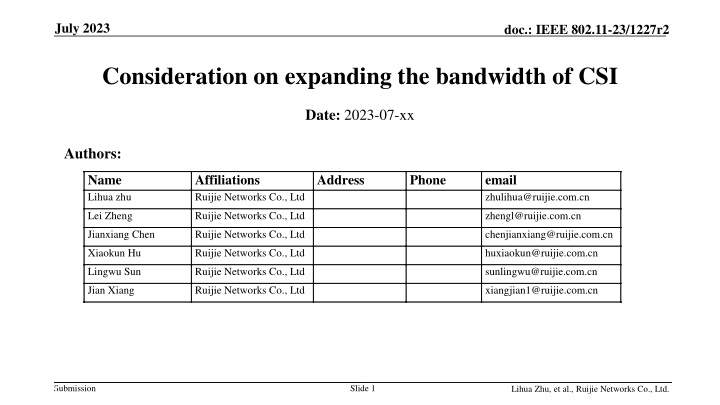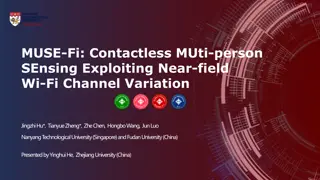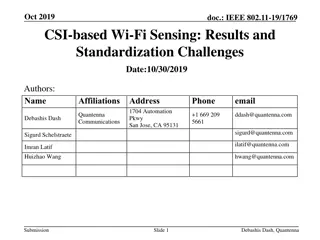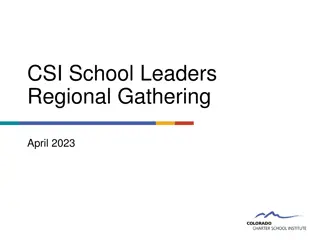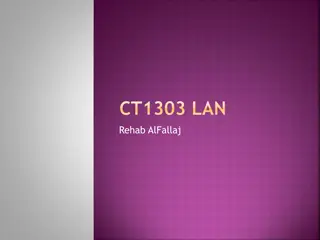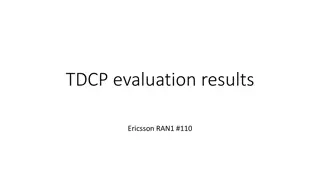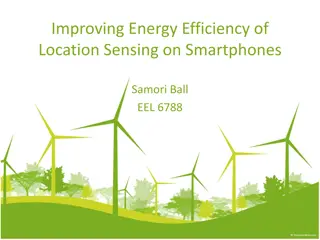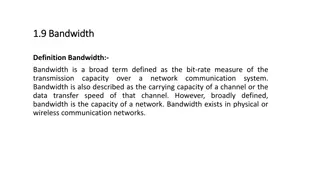Enhancing Bandwidth of Channel State Information (CSI) for Wireless Sensing Applications
This submission delves into the necessity of expanding the bandwidth of Channel State Information (CSI) in wireless environments to cater to the demands of time-sensitive wireless sensing applications. It explores the implications of high-bandwidth CSI on enhancing wireless channel understanding, accuracy of location services, and the resolution of time-of-flight estimation. Practical cases are discussed to illustrate the critical role that bandwidth plays in achieving precise wireless environment perception and reliable performance. The importance of high-bandwidth CSI in improving the accuracy of ranging and localization is also highlighted. Overall, expanding CSI bandwidth emerges as a crucial factor in enabling more accurate and reliable wireless communication systems.
Download Presentation

Please find below an Image/Link to download the presentation.
The content on the website is provided AS IS for your information and personal use only. It may not be sold, licensed, or shared on other websites without obtaining consent from the author.If you encounter any issues during the download, it is possible that the publisher has removed the file from their server.
You are allowed to download the files provided on this website for personal or commercial use, subject to the condition that they are used lawfully. All files are the property of their respective owners.
The content on the website is provided AS IS for your information and personal use only. It may not be sold, licensed, or shared on other websites without obtaining consent from the author.
E N D
Presentation Transcript
July 2023 doc.: IEEE 802.11-23/1227r2 Consideration on expanding the bandwidth of CSI Date: 2023-07-xx Authors: Name Lihua zhu Affiliations Ruijie Networks Co., Ltd Address Phone email zhulihua@ruijie.com.cn Lei Zheng Ruijie Networks Co., Ltd zhengl@ruijie.com.cn Jianxiang Chen Ruijie Networks Co., Ltd chenjianxiang@ruijie.com.cn Xiaokun Hu Ruijie Networks Co., Ltd huxiaokun@ruijie.com.cn Lingwu Sun Ruijie Networks Co., Ltd sunlingwu@ruijie.com.cn Jian Xiang Ruijie Networks Co., Ltd xiangjian1@ruijie.com.cn Submission L Slide 1 Lihua Zhu, et al., Ruijie Networks Co., Ltd.
July 2023 doc.: IEEE 802.11-23/1227r2 Introduction This submission briefly discusses: - Requirements for high-band CSI(Channel State Information) capture The bandwidth of single-channel CSI is no longer sufficient to meet the demands of wireless sensing applications(especially time-resolution sensitive ones) - What can be done to expand the bandwidth of CSI Submission L Slide 2 Lihua Zhu, et al., Ruijie Networks Co., Ltd.
July 2023 doc.: IEEE 802.11-23/1227r2 Requirements of high-bandwidth CSI CSI provides detailed information about the wireless channel, including the amplitude, phase, and frequency response. The higher resolution and more precise information offered by high-bandwidth CSI allow for better understanding and interpretation of the wireless environment. This, in turn, enables more accurate and reliable performance in perception tasks. Submission L Slide 3 Lihua Zhu, et al., Ruijie Networks Co., Ltd.
July 2023 doc.: IEEE 802.11-23/1227r2 Requirements of high-bandwidth CSI Some practical cases: The resolution of TOF estimation is inversely proportional to the channel bandwidth. Therefore, the bandwidth is the major factor in determining time resolution and the distinguishable multipath components of the received signal based on the channel response. For example, given the widely used WiFi channel bandwidth at 5GHz is 40MHz, which yields a time of flight resolution of 25ns. Such a low bandwidth makes each received multipath component not resolvable due to the insufficient time resolution of each channel within a typical indoor environment. Submission L Slide 4 Lihua Zhu, et al., Ruijie Networks Co., Ltd.
July 2023 doc.: IEEE 802.11-23/1227r2 Requirements of high-bandwidth CSI High-bandwidth CSI can also improve the accuracy of location. As proposed in [2], the wider the bandwidth Splicer uses, the smaller error the ranging can achieve. When splicing up to 200MHZ bandwidth, the ranging and localization can be reduced to sub-meter level, which can be seen in the right picture. C CDF of ranging errors with various bandwidth[1] Submission L Slide 5 Lihua Zhu, et al., Ruijie Networks Co., Ltd.
July 2023 doc.: IEEE 802.11-23/1227r2 Requirements of high-bandwidth CSI Tan in [3] reveals that fruit ripeness detection can benefit from high-bandwidth CSI too. Almost all sensing applications can benefit from high-bandwidth CSI, and we won t go into detail on each of them here. However, in order to get higher bandwidth on current commodity WiFi devices, it requires scanning multiple channels within the coherence time. For example, it needs to scan 20 available channels within less than 500ns to leverage all the channels at 5GHZ(i.e., over 600MHZ)[2] So, may be some measures should be taken to expand the bandwidth of CSI and even become a standard, rather than requiring users to seek solution by themselves. But it seems nothing about this issue has been discussed in TGbf. Submission L Slide 6 Lihua Zhu, et al., Ruijie Networks Co., Ltd.
July 2023 doc.: IEEE 802.11-23/1227r2 Possible solution Sending channel switch instructions based on some rules(such as polling on all available channels) to STA, and let it work on various channels during CSI collection to achieve high-bandwidth CSI acquisition. It requires AP and STA both support channel switch. Two approaches can be considered: 1. Modifying existing channel switching frames: This approach involves making changes to the existing frames used for channel switching. This can include modifying the fields or parameters within the frames to optimize the channel switching process. By improving the efficiency and effectiveness of the existing frames, seamless channel switching can be achieved. Submission L Slide 7 Lihua Zhu, et al., Ruijie Networks Co., Ltd.
July 2023 doc.: IEEE 802.11-23/1227r2 Possible solution Specifically, changing relevant field in Channel Switch Announcement element of Beacon Frame during CSI collection. Quoting from[4] For example, Channel Switch Mode should be 1 ensuring uninterrupted CSI collection; New Channel Number can be set to poll on all available channels; And Channel Switch Count set as 0 to switch channel immediately. Submission L Slide 8 Lihua Zhu, et al., Ruijie Networks Co., Ltd.
July 2023 doc.: IEEE 802.11-23/1227r2 Possible solution Another approach: 2. Adding new channel switching methods: In this approach, new methods or techniques for channel switching are introduced. These methods can be designed to overcome the limitations or drawbacks of the existing channel switching mechanisms. This may involve developing new frame structures, algorithms, or protocols that enable faster and more efficient channel switching, ensuring uninterrupted connectivity. Submission L Slide 9 Lihua Zhu, et al., Ruijie Networks Co., Ltd.
July 2023 doc.: IEEE 802.11-23/1227r2 Possible solution Specifically, during Sensing measurement setup specify a certain interval for STA to automatically switch channels across on all available channels without the need for multiple triggers. Quoting from[5] Submission L Slide 10 Lihua Zhu, et al., Ruijie Networks Co., Ltd.
November 2022 doc.: IEEE 802.11-23/1227r2 Summary By capturing a larger bandwidth of CSI, more fine-grained details of the channel characteristics can be obtained. With high-bandwidth CSI, wireless sensing applications such as localization, tracking, gesture recognition, and object detection can benefit from improved accuracy. How to collect CSI beyond bandwidth of single channel become an important issue. So this presentation provides some possible solutions, and hope this issue can attract more discussion. Submission L Slide 11 Lihua Zhu, et al., Ruijie Networks Co., Ltd.
November 2022 doc.: IEEE 802.11-23/1227r2 References [1] Y. Xie, Z. Li, and M. Li, Precise power delay profiling with commodity wifi, in Proceedings of the 21st Annual International Conference on Mobile Computing and Networking, pp. 53 64, 2015. [2] S. Tan, Y. Ren, J. Yang and Y. Chen, "Commodity WiFi Sensing in Ten Years: Status, Challenges, and Opportunities," in IEEE Internet of Things Journal, vol. 9, no. 18, pp. 17832-17843, 15 Sept.15, 2022 [3] S. Tan, L. Zhang, and J. Yang, Sensing fruit ripeness using wireless signals, in 2018 27th International Conference on Computer Communication and Networks (ICCCN), pp. 1 9, IEEE, 2018. [4] IEEE Std 802.11TM-2020 [5] IEEE Std 802.11bfTM D1.1 Submission L Slide 12 Lihua Zhu, et al., Ruijie Networks Co., Ltd.
